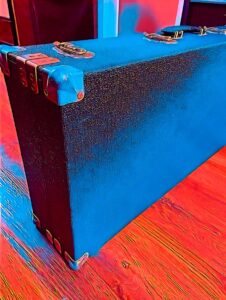As an Amazon Associate Playpedalsteel.com earns from qualifying purchases. This page contains affiliate links.
Having a reliable case can go a long way for any instrument, and the pedal steel is no different. Considering its heavier weight, various assemblage parts, and value, the pedal steel can benefit greatly from the added protection and convenience that cases provide.
But with pedal steel being a niche instrument, and manufacturers are often producing just enough new steel guitars to keep up with demand, where do you find a case for your pedal steel if it doesn’t already have one?
Most pedal steels that are built new come with a case from the manufacturer or builder. You can also find used pedal steel cases for sale, however they’re usually sold with an accompanying used pedal steel.
Let’s take a closer look at pedal steel cases, and why they can be a worthwhile piece of gear…
Features and Details
Most pedal steel cases are hard cases that come with a storage area for the cabinet and body of the guitar, and a separate area for its rods and legs when it is disassembled. Often these are held in a leather-type bag that was originally provided by the pedal steel’s manufacturer.
Pedal steels are usually placed face down in their cases, and the undercarriage and its mechanics are visible to the player when looking down in the case. You usually assemble the pedal steel in its case, first by attaching the legs, and then the pedal bar and rods.
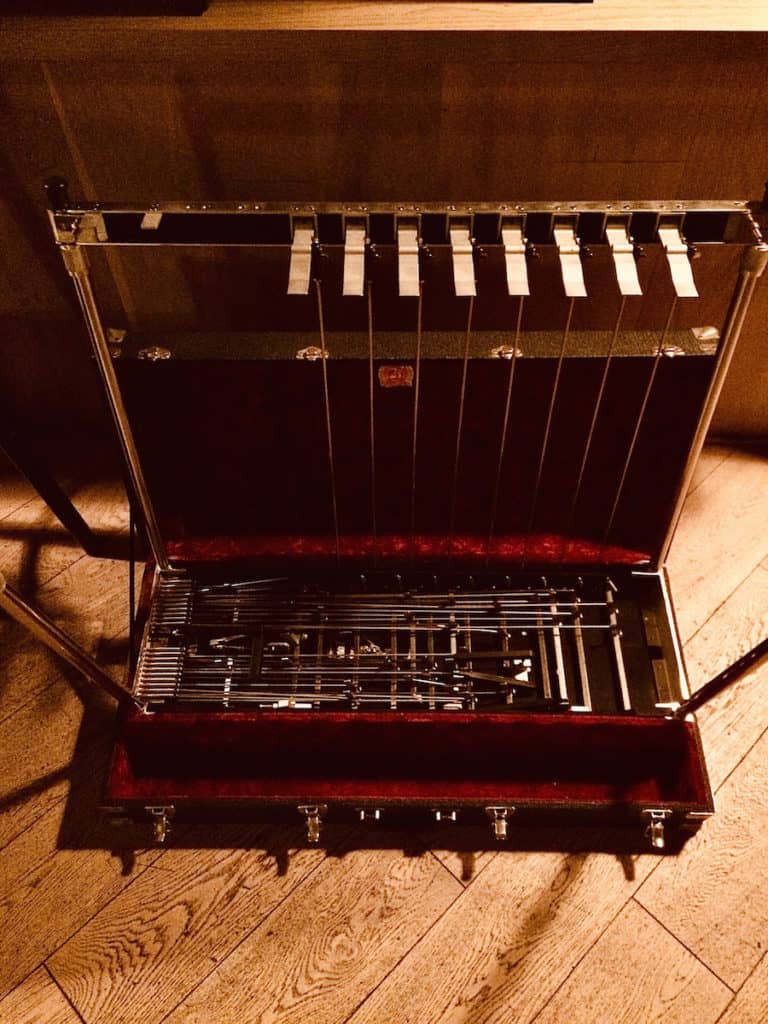
Some pedal steel cases are “split” cases, where there are two separate cases: one for the body of the guitar, and another for its legs, pedal bar, and rods. Split cases have the added benefit of lightening each carry load for the player, and can also make the pedal steel more portable in certain ways.
Hard Case vs. Soft Case
Most pedal steel cases are hard cases, and rarely will you see players using soft cases. Because of how heavy they are, their value, and the importance of their mechanical functionality while playing, pedal steels are usually kept in hard cases by players to protect them from damage.
Having a hard shell case, with its harder sides and padded insert, can be a great way to protect the instrument while traveling, transporting the pedal steel, storing it, assembling it, and even shipping it. Most hard shell pedal steel cases are heavier than regular guitar cases, and are rectangular shaped like a keyboard case.
Soft cases can provide extra protection from the elements, and make transporting the pedal steel and its accessories easier. However, you’ll lose a lot of the added protection that the hard edges, sides, and walls that the hard shell case provides. You’ll likely want to be more careful in how you transport your pedal steel when using a soft case, and be more gentle with handling it overall.
Don’t let soft cases fool you though, they can be a great inexpensive way to find a case for your pedal steel, until you find a hard shell case. Check out this equipment carrying case from LimoStudio (link to Amazon), which can be a good option if you have a single neck pedal steel guitar.
Brands and Case Makers
Although most cases come directly from manufacturers when you purchase a new pedal steel guitar, there are some companies that make custom pedal steel cases. These brands may be a good option if you can’t find the original manufacturers case for your guitar, or if you’re looking to customize certain aspects of the case.
Here are some current brands that offer custom cases for pedal steel guitar:
Some of the benefits of custom cases include choices for exact sizing, particular foam/padding materials, case color, latch types, and case type. If you are flying or shipping your pedal steel guitar, you may want consider using a flight case, which can provide added protection for handling.
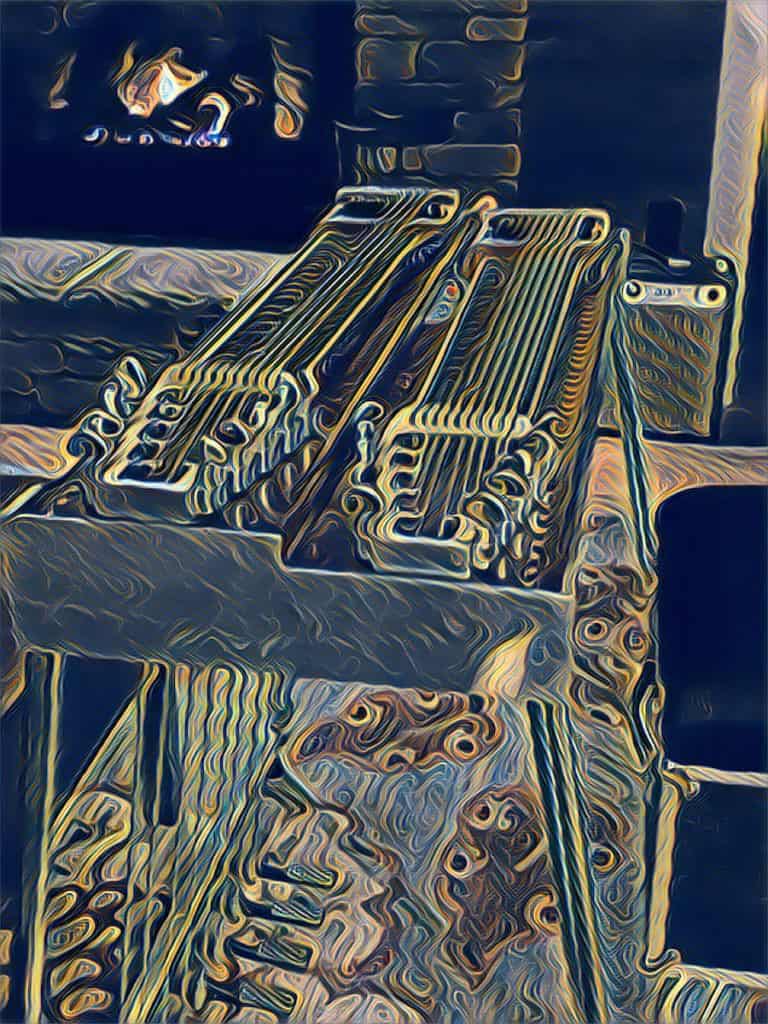
Flight Cases and Shipping Pedal Steels
Although flying or shipping your pedal steel can seem scary, due to the potentials of it getting damaged during handling, there are many pedal steels that are flown or shipped almost daily with success. Of course, a lot of this depends on how you pack and carry the pedal steel.
If you’re going to be shipping your pedal steel, it can be a good idea to ship it in its hard shell case, and then use another (usually custom-built) wooden crate or box to further secure and pack it. Before shipping your pedal steel, I recommend researching and reading what previous players and builders have done when shipping their guitars. The Steel Guitar Forum is a good site for finding this kind of information.
Furthermore, if you’re going to fly with your pedal steel, it can be beneficial to use a flight case. Flight cases can provide extra protection and durability during transportation, which can be important if you’re flying somewhere to play a gig with your pedal steel.
Check out Pelican cases, SKB, and Keal Cases if you’re looking for flight cases that may work well for your pedal steel. Also, some of the custom case brands mentioned earlier may build flight cases as well.
If you have the know-how and professional skills, you can custom fit your own Pelican case for your pedal steel. I recommend Pelican’s Air 1745 case (click to see on Amazon) for many double neck pedal steels, which has dimensions that will give you plenty of space inside to fit your pedal steel and enough room on top (inside) for the case to close. The wheels, weather protection, handles, and overall protection that this case provides are well worth it when traveling with your pedal steel.
In order to make this kind of case work well with your pedal steel, you’ll have to make sure you build or fit your foam and other materials to snugly fit the pedal steel so that there is very minimal to no movement of it at all. When the pedal steel moves in the case, this is when it is more likely to get damaged when flying, handling, or traveling with your pedal steel.
A nice solution or process for custom fitting your Pelican case is to build a wooden box that is shaped exactly the same as the current case that your pedal steel fits in (if it fits well and securely in your current case). If you use the same dimensions for this, then you’ll be sure your pedal steel’s body can fit well in the box, which you can then place and secure into the Pelican case you’ll be using.
If you do this with the Pelican 1745 case, then you’ll still have plenty of extra room for storing your pedal bar, legs, and rods. You’ll likely have extra room to store some cables, pedals, or accessories as well.
Most Pelican cases have the option of foam coming with the case, which can be very handy when customizing your case. If you need more foam, then I recommend replacement foam such as this from Carolina Custom Foam (click to see on Amazon), but be sure to get the right size, amount, and thickness for your building needs. There are many different size options if you browse for what you’re looking for.
Also, some players recommend custom fitting and using the SKB 3614-6 case for single neck pedal steels (and some double neck cabinets). Here’s a similar SKB option (available on Amazon), but be sure to double-check the dimensions and get the right size case before buying any SKB case – there may be different 3614 series models available, and you’ll want to find the right size case for your specific pedal steel guitar or custom case build.
Using the Case for Assembly
You can use the case to hold your pedal steel guitar as you assemble it for playing. Usually players will lay the case down on the floor, and open its top half to reveal the contents. The body of the pedal steel will be upside down, showing the undercarriage and where the legs attach to the guitar.
From here, most players will attach the legs of the pedal steel, then the pedal bar, and then the particular pedal rods. At this point, the pedal steel can be carefully lifted from the case, and flipped over so that the legs can be placed on the ground for the instrument to be played.
When the pedal steel is in the case, and it is assembled before being taken out, you can examine the undercarriage of the pedal steel. This is a good way to check if the pedal steel needs oiling, has any mechanical issues, and to assess the tuning and copedent setup.
Conclusion
Most pedal steel guitars are built with a high quality of craftsmanship, so it can be worthwhile to protect them with a nice case. Not only will a case protect your pedal steel however, it can also be a comfortable way to carry the instrument in a non-hassle way to gigs, rehearsals, and sessions.
Many pedal steel guitar cases can be used for years before needing to be replaced, and many can be resold to players looking for cases. A pedal steel case can be one of the most worthwhile, used, and beneficial pieces of gear you can use for your pedal steel guitar.
Thanks for checking out this page, hope it is helpful and makes playing more enjoyable! If you’re interested in diving deeper into playing E9 pedal steel, check out these resources and guides…
The Chord Guide for E9 Pedal Steel (E-Book, Digital Download)

Learn the chords on the E9 neck in a way that makes playing simple and enjoyable…
- Almost Every Chord You’ll Ever Need for E9
- Intuitive and Easy to Use
- Make Use of Pedal and Lever Combinations
- Example Tabs of Chord Movements
- Easily Utilize the Nashville Number System
- Great For Any Key and Style of Music
Includes a bonus section of over a hundred pages of extra chord charts, key references, and more!
You may also like…
200 Country Riffs & Licks for E9 Pedal Steel
Add these country licks to your playing repertoire…
- Easy to Read Format
- Includes Rhythmic Notation
- Playing Over Chord Changes
- Great for Country, Alt-Country, & Honky-Tonk Styles
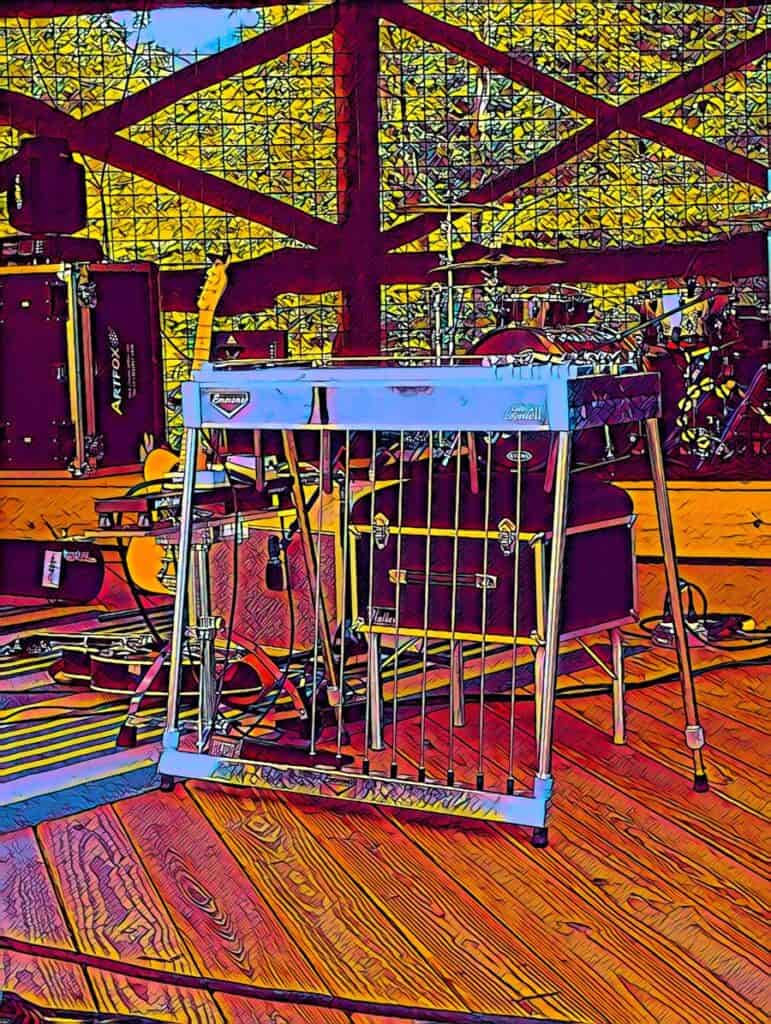

The Scale Book for E9 Pedal Steel
Over 1,000 Pages with Tabs and Diagrams!
- Easy to Use Reference for Practicing
- All Major and Minor Pentatonic Scales, Modes, Major Scales
- All Keys, and Covers the Fretboard
- Includes Pockets of Scales
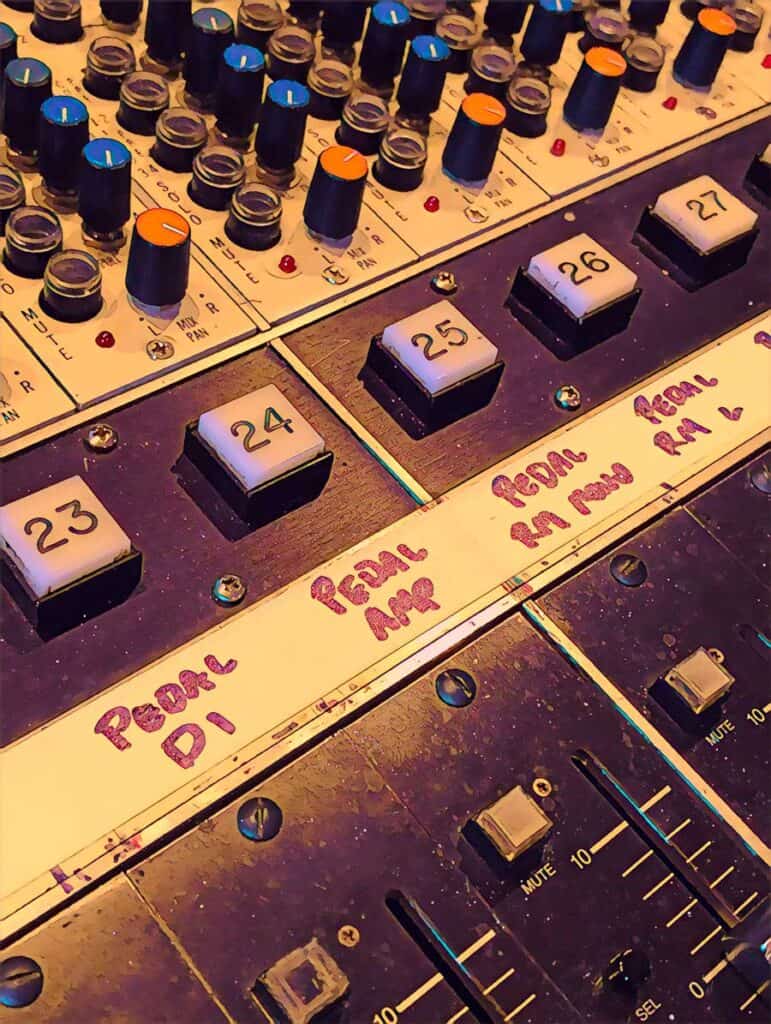
Harmonized 6ths
- Hundreds of Riffs, Licks, and More
- How To Play Sixth Intervals on the E9 Neck – Over Any Chord
- Utilizes The Pedals and Knee Levers

Right Hand Picking & Blocking
- An In-Depth Guide to Picking and Blocking
- Perfect Your Technique
- Includes Graphics, Illustrations, & Practice Exercises
